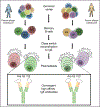The Secret Life of IgE-Producing Cells
- PMID: 30784576
- PMCID: PMC9832915
- DOI: 10.1016/j.immuni.2019.01.018
The Secret Life of IgE-Producing Cells
Abstract
IgE antibodies are essential mediators of allergies. In a recent study in Science, Croote et al. (2018) characterize IgE cells isolated from individuals allergic to peanuts. Their findings provide insight into the differentiation of IgE cells in humans and have implications for our understanding of allergic disease.
Copyright © 2019 Elsevier Inc. All rights reserved.
Figures

Comment on
-
High-affinity allergen-specific human antibodies cloned from single IgE B cell transcriptomes.Science. 2018 Dec 14;362(6420):1306-1309. doi: 10.1126/science.aau2599. Science. 2018. PMID: 30545888
References
-
- Beck LA, Thaçi D, Hamilton JD, Graham NM, Bieber T, Rocklin R, Ming JE, Ren H, Kao R, Simpson E, et al.. (2014). Dupilumab treatment in adults with moderate-to-severe atopic dermatitis. N. Engl. J. Med 371, 130–139. - PubMed
-
- Berkowska MA, Heeringa JJ, Hajdarbegovic E, van der Burg M, Thio HB, van Hagen PM, Boon L, Orfao A, van Dongen JJ, and van Zelm MC (2014). Human IgE(+) B cells are derived from T cell-dependent and T cell-independent pathways. J. Allergy Clin. Immunol 134, 688–697.e6. - PubMed
-
- Croote D, Darmanis S, Nadeau KC, and Quake SR (2018). High-affinity allergen-specific human antibodies cloned from single IgE B cell transcriptomes. Science 362, 1306–1309. - PubMed
-
- He JS, Narayanan S, Subramaniam S, Ho WQ, Lafaille JJ, and Curotto de Lafaille MA (2015). Biology of IgE production: IgE cell differentiation and the memory of IgE responses. Curr. Top. Microbiol. Immunol 388, 1–19. - PubMed
Publication types
MeSH terms
Substances
Grants and funding
LinkOut - more resources
Full Text Sources
Medical

